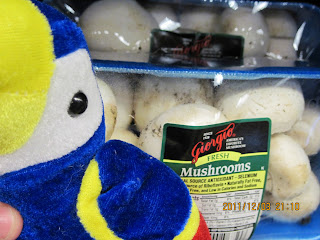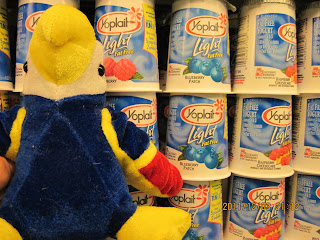Saturday, September 3, 2011
Cohesion
In this picture you can see that while it began to rain, the rain began to join together forming droplets on the windshield. This is because of the process of cohesion.
Sources:
Mrs. Beethe's notes.
Adhesion
Tape is a common form of an adhesive that we often use around the house so I decided it would make a good example for adhesion.
Sources:
Mrs. Beethe's notes.
Evaporative Cooling
Over the cup of boiling water you can see steam rising up, this steam helps in the process of evaportive cooling as it releases heat in the form of that steam to cool the water faster.
Sources:
Mrs. Beethe's notes.
Friday, September 2, 2011
Carnivore
This big fella is a fish found at the local aquarium and he is a carnivore because his diet is only based off of other meaty fish.
Sources:
Mrs. Beethe's notes.
Herbivores
Animals can be classified into three different types of dietary groups and those three are herbivores, carnivores and omnivores. Herbivores are consumers of producers and autotrophs as they eat mainly plants or fungi organisms. Herbivores are given their title because they stick to eating leafy greens and other plants, they do not however eat any forms of meat. Often herbivores tend to stay away from those that are meat eaters because they are creatures that hold nutrients that those meat eaters would consume in order to gain. A strange adaptation that these herbivores often have is that their teeth are more dull rather than sharp unlike carnivores because they do not use their teeth to sink into flesh of other animals. A few examples of herbivores would be koalas, llamas, cows and squirells.
Sources:
Mrs. Beethe's notes.
Sources:
Mrs. Beethe's notes.
Epistasis
My dumb little dog oreo is an example of the outcome of epistasis. His mother was a pure black toy poodle and his father was all white, his brother ended up being black like his mother but he ended up being a mix of both the black and white genes.
Epistasis is when there is an interaction going on between two or more genes to control a phenotypes behavior. The number of genes interacting with eachoter during epistasis can be found using the Mendelian Genetics chart to find their genetic ratio. Epistasis can affect color, shape, texture and a few other features of different organisms depending on what the genes differ with when being interacted with one another. An example of epistasis that was actually observed by Gregor Mendel himself was the pea pod genetic changes where he saw changes in varying pea pod plants that had grown into different shapes, sizes and colors.Sources:
McClean, Phillip. Gene Interactions. ndsu.edu. Retrieved September 2, 2011, from http://www.ndsu.edu/pubweb/~mcclean/plsc431/mendel/mendel6.htm
Thursday, September 1, 2011
Thermoregulation
I took this picture because my dog usually find ways to keep his body temperature maintained such as if it's too hot in the house he'll pant and release heat and like with the air conditioner he just enjoys the cool with his fur so he manages his body temperature using thermoregulation.
Sources:
Thermoregulation. harvard.edu. Retrieved September 1, 2011, from http://www.deas.harvard.edu/courses/es96/spring1997/web_page/health/thermreg.htm
Epithelial Tissue
The skin on my arm and hand are both considered epithelial tissue as they are located on the outter external part of my body.
Sources:
Epithelial Tissue. uwc.ac.za. Retrieved September 1, 2011, from http://www.bcb.uwc.ac.za/sci_ed/grade10/mammal/epithelial.htm
Invertabrates
Jellyfish are common forms of invertabrates and can move freely, their tentacles are an adaptation that they use to protect themselves.
Sources:
Mrs. Beethe's notes.
Fungi
Locally grown or found in the forests, mushrooms are a form of fungi that can be either enjoyable or deadly depending on what form of mushrooms they are.
Sources:
Mrs. Beethe's notes.
Bacteria
Yogurt such as these containers of Yoplait are forms of good bacteria that we can actually consume, not all bacteria is like that found in yogurt.
Sources:
Mrs. Beethe's notes.
Wednesday, August 31, 2011
Kingdoms
These are the five different kingdoms and a picture for each classification. I couldn't find a way of showing the kingdoms myself so I used an image from online.
All living organisms can be brought into one or more of five categories, those five categories being the Monera, Protista, Fungi, Plantae and Animalia kingdoms. Those kingdoms can be broken down even further into subdivided divisions for plants, or phyla for animals. The monera kingdom is made up of prokaryotic cells such as eubacteria or cyanobacteria. The other four kingdoms are eukaryotic leaving the monera kingdom as the only prokaryotic kingdom. The protista kingdom is made up of mainly unicellular protozoans along with microscopic and macroscopic algae. The fungi kingdom consists of mainly haploid and dikaryotic cells, they are multicellular and often heterotrophic. The plantae kingdom is mainly made up of species with haplo-diploid life cycles, are often autotrophic and contain their embryo within the female sex organ of the parent plant.Sources:
The Five Kingdoms of Life. palomar.edu. Retrieved August 31, 2011, from http://waynesword.palomar.edu/trfeb98.htm
Tuesday, August 30, 2011
Population
The goldfish in our fishtank are considered their own little population as they are from the same species and interact and develop in their own little environment.
A population can be classified as a group of the same type of species that live in the same geographical area. This area is usually the location that mainly inter-breeding occurs within the population. An example of a population would be a lake that holds a group of koi fish that inter-breed with eachother and reproduce to expand their population in the lake.Sources:
Mrs. Beethe's notes.
Friday, August 26, 2011
Homologous Structures
My cat Mya is an animal that has parts that would be considered homologous structures, one being her arms as they share common characteristics to that of humans and other creatures.
Sources:
Homologous Structures. gsw.edu. Retrieved August 26, 2011, from http://itc.gsw.edu/faculty/bcarter/histgeol/paleo2/homol1.htm
Vestigial Organs
My ugly little toe is considered a vestigial organ because it's not a necassary organ needed for me to continue on living my life.
Sources:
A. Covey, Jon. Vestigial Organs. creationinthecrossfire.com. Retrieved August 26, 2011, from http://www.creationinthecrossfire.com/Articles/VestigialOrgans.html
Photosynthesis
These are some plants (fake as you can see), I took a picture of them because plants are among the different organisms that can perform the process of photosynthesis.
Photosynthesis is basically the conversion of sunlight into natural sugars that can later be used in cellular respiration to form ATP, or energy. This process can take place in plants, some forms of bacteria and even some protistans. The process of photosynthesis is often associated with the green pigment called chlorophyll and it releases the oxygen that we humans need to survive.Sources:
Photosynthesis. maricopa.edu. Retrieved August 26, 2011, from http://www.emc.maricopa.edu/faculty/farabee/biobk/biobookps.html
Thursday, August 25, 2011
Heterotroph
Heterotrophs are the opposite of autotrophs, rather than producing their own energy from inorganic sources they instead consume other organisms to obtain the energy from those consumed organisms. Heterotrophs are the dominant organisms of the food chain as they consume autotrophs for their stored energy. Examples of heterotrophs would be animals like birds, felines or even humans as we too eat autotrophs (fruits and vegetables) in order to receive nutrients to maintain a balanced diet.
Sources:
Mrs. Beethe's notes.
Sources:
Mrs. Beethe's notes.
Autotroph
This picture displays some plants (also fake), I took another picture of a plant because plants are a form of autotroph as they create their own nutrients through their bodies.
An autotroph would be considered a form of organism that has the ability to take in inorganic energy such as the energy provided from either photosynthesis or chemosynthesis and applying it to form nutrients for itself. Autotrophs can be classified on the food chain as producers and they are similar to the use of solar panels. With solar panels, the panes usually absorb the light they receive and form an energy source for whatever they are linked to. Autotrophs are extremely similar because they also capture solar energy and can apply it to themselves.Sources:
Autotroph. biology-online.org. Retrieved August 25, 2011, from http://www.biology-online.org/dictionary/Autotroph
Wednesday, August 24, 2011
Cellular Respiration
Cellular Respiration is a process that is needed to revert stored energy into adenosine triphosphate which is also known as ATP. This process can occur in both eukaryotic and prokaryotic cells and revolves in three cycles which are glycolysis, the citric acid cycle and electron transport. After cellular respiration has occured in a cell, if the cell was eukaryotic it would have a maximum ATP yield of 36. Prokaryotic cells however would end up with a maximum ATP yield of 38 and this is because eukaryotic cells lose two ATP molecules when passing through the mitochondrial membrane after the process of glycolysis.
Sources:
Bailey, Regina. Cellular Respiration. about.com. Retrieved August 24, 2011, from http://biology.about.com/od/cellularprocesses/a/cellrespiration.htm
Sources:
Bailey, Regina. Cellular Respiration. about.com. Retrieved August 24, 2011, from http://biology.about.com/od/cellularprocesses/a/cellrespiration.htm
Osmosis
Although it's hard to see, those are little pieces of sea salt that I had piled in a plate filled with water and osmosis occured in the plate as the water was absorbed from one side of the plate to the portion with the salt found in it.
Sources:
Diffusion and Osmosis. biologycorner.com. Retrieved August 24, 2011, from http://www.biologycorner.com/bio1/diffusion.html
Enzymes
In this picture you can see the fire from the burner, this fire acts as an enzyme to the water in the pan helping to speed up the process of boiling the water itself.
Made up of amino acids, these catalysts are essential for creating cells and speeding up chemical reactions. Enzymes are made up of many linked amino acids that work together to speed up the functions in a cell making it possible for that cell to regulate its' tasks in a unique and specific fashion. Different cells require different numbers of enzymes, but in order for that cell to continue to function there must be some form of enzyme activity allowing these cells to perform their functions.Sources:
Brain, Marshall. How Cells Work. howstuffworks.com. Retrieved August 24, 2011, from http://science.howstuffworks.com/environmental/life/cellular-microscopic/cell2.htm
Base
Soaps such as this AJAX dish soap and other types of detergants are considered forms of bases.
A base is a compound that contains hydroxide ions when it is dissolved in water. Bases are also measured on the pH scale and are referred to as alkalis, these bases give solutions with hydrogen ion activity that is lower than the activity in pure water. Basic substances lie on the pH scale ranging from any substance with a pH level higher than 7.0 up to a pH level of 14, 14 being the strongest form of a basic substance. A weak base would be considered baking soda or common sea water. A stronger basic substance would be Ammonia or Lye.Sources:
Ophardt, E. Charles. Acids and Bases. elmhurst.edu. Retrieved August 24, 2011, from http://www.elmhurst.edu/~chm/vchembook/184ph.html
Acid
These lemons are a form of acid because they hold a high acidity content level.
An acid would be considered any compound that contains either hydrogen ions or hydronium ions when it is dissolved in water. Acids can be measured using the pH scale to determine how concentrated or diluted the acid is. A strong acid with the pH level of 1 or 0 would be a substance such as battery acid. A weaker acidity such as a level 6 acid on the pH scale would be found in normal range precipitation. The range of acidity levels on the pH scale are measured from 0 to 6, 0 being the strongest level of acidity.Sources:
Ophardt, E. Charles. Acids and Bases. elmhurst.edu. Retrieved August 24, 2011, from http://www.elmhurst.edu/~chm/vchembook/184ph.html
Subscribe to:
Comments (Atom)




















